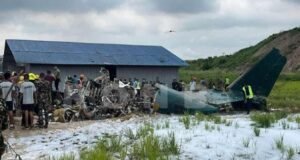
Some victims managed to send messages after the landslide hit, Gonzales said, adding that elderly women and a child were among the dead.
Nimrod Parba, a 26-year-old resident, said a relative trapped in a house beneath the rubble managed to call Thursday morning and begged to be rescued. The calls stopped, however, and the relative could not be reached hours later, Parba said.
Naga city Mayor Kristine Vanessa Chiong said at least 64 people remained missing.
“We’re really hoping we can still recover them alive,” she said.
The landslide hit while several northern Philippine provinces are still dealing with deaths and widespread damage wrought by Typhoon Mangkhut, which pummeled the agricultural region Saturday and left at least 88 people dead and more than 60 missing. A massive search is still underway for dozens of people feared dead after landslides in the gold-mining town of Itogon in the north.
Cebu province was not directly hit by Mangkhut but the massive typhoon intensified monsoon rains across a large part of the archipelago, including the central region where Naga city lies about 570 kilometers (355 miles) southeast of Manila.
Rescuers were treading carefully in small groups on the unstable ground to avoid further casualties.
“We’re running out of time. The ground in the area is still vibrating. We’re striking a balance between intensifying our rescue efforts and ensuring the safety of our rescuers,” Naga city Councilor Carmelino Cruz said by phone.
Cristita Villarba, a 53-year-old resident, said her husband and son were preparing to leave for work when the ground shook and they were overwhelmed by a roar.
“It was like an earthquake and there was this thundering, loud banging sound. All of us ran out,” Villarba said, adding that she, her husband and three children were shocked but unhurt.
Outside, she saw the house of her older brother, Lauro, and his family buried in the landslide.
“Many of our neighbors were crying and screaming for help. Some wanted to help those who got hit but there was too much earth covering the houses, including my brother’s,” she said.
Nearly 20 people lived in her brother’s home, mostly his family and grandchildren, she said.
Villarba said she had felt sorry a few days earlier for the landslide victims in the country’s north.
“I had no idea we would be the next,” she said.
Elsewhere in the landslide-hit community, a father and his young daughter were found dead in each other’s embrace in a house, volunteer rescuer Vic Santillan said.
It’s not clear what set off the landslide, but some residents blamed limestone quarries, which they suspect may have caused cracks in the mountainside facing their villages. Villarba said a light rain stopped when the landslide hit and there was no rain on Wednesday.
The nearest quarry was abandoned about a year ago, but another government-authorized quarry is still being operated not far away, and villagers also profit from the limestone business, said Angeline Templo, an assistant to the mayor.
The Philippines is one of the world’s most disaster-prone countries. It is lashed by about 20 storms each year and is located in the Pacific “Ring of Fire” that is vulnerable to earthquakes and volcanic eruptions. Poverty has forced many to live on or near volcanoes, steep mountains and storm-vulnerable coasts, often leading to disasters.
 Weekly Bangla Mirror | Bangla Mirror, Bangladeshi news in UK, bangla mirror news
Weekly Bangla Mirror | Bangla Mirror, Bangladeshi news in UK, bangla mirror news







